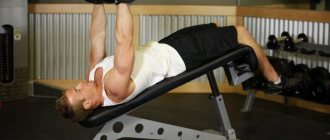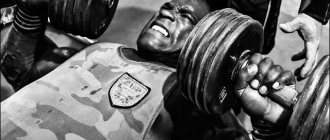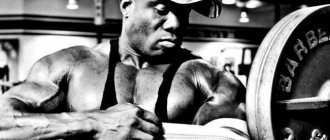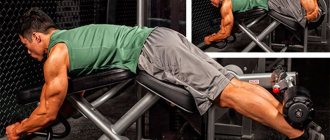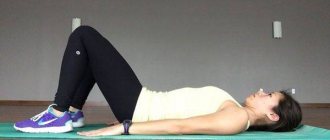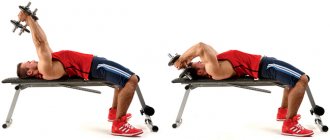Raising your arms with dumbbells while lying on a horizontal bench is one of the additional exercises for building the pectoral muscles. It is aimed at stretching the pectoralis major muscles. Arnold Schwarzenegger himself performed this isolation exercise in every chest workout. Let's look at the importance and features of this seemingly simple and ineffective, compared to basic, exercise.
The benefits and harms of lying dumbbell flyes
Pros of exercise
- First of all, the exercise stretches and well nourishes the tissues of the pectoral muscles with blood; at the end of the approach, the muscles are abundantly enriched with blood, which has a positive effect on their volume.
- Also, the wiring prevents the muscles from becoming stiff and shortened from constant contraction through strength exercises.
- Essentially, stretching the fibers helps to enlarge the chest.
- The exercise forms a beautiful, sculpted chest.
- Another advantage of this exercise is the use of a small working weight.
Dumbbell flyes are an excellent exercise for stretching and contracting muscles at the same time.
Minuses
Dumbbell flyes can be harmful if the athlete does not adhere to the correct technique.
- Firstly, there is a possibility of rupture of muscles and ligaments if the stretching is too intense, in which the dumbbells are moved too far to the sides.
- Secondly, it is the selection of too much weight, which injures fibers and tissues that are unable to withstand heavy loads.
Dumbbell Incline Press for Upper Pectorals
This exercise with dumbbells is aimed at pumping the upper pectoral muscles.
Technique: dumbbells weighing 2–3 kg. Perform 3-4 sets of 10-15 lifts.
The dumbbell bench press exercise is very effective in developing the pectoral muscles.
- Take a lying position on an inclined support. Palms are parallel. Hold a dumbbell in each hand.
- Place the weights on the knee part. From this position, use your legs to throw the weights onto the shoulder line.
- When your hands are in the top position, turn your wrists away from you. In this case, the angle between the shoulders and forearms is 90°.
- As you exhale, smoothly but quickly “squeeze” the weights from the chest up in an arc, bringing them above the body.
- Hold your hands in the top position for a second, then slowly return them to the starting position.
Don't miss the most popular article in the section: Body drying for girls. Training program, detailed nutrition menu for the month by day.
What muscles work when lying down on dumbbell raises?
- The main load falls on the pectoralis major muscles.
- Static load falls on the abs, biceps and triceps.
- The anterior deltoid muscles and serratus muscles are also involved in the work
Exercise technique
Let's look at how to properly perform the negative and positive incline exercise.
Dumbbell flyes while sitting on an incline bench upside down
So, as we said earlier, in this variation we focus on the upper pectoral muscles.
When flattening, do not hit the dumbbells against each other.
Technique:
- We set the bench at an angle of 15 to 30 degrees.
- We place dumbbells next to the bench on the sides.
- We sit on the edge, lift the dumbbells and place them on our hips.
- At the same time pushing the projectile towards you with your feet, we lie down on the bench.
- We have dumbbells in our bent arms near our chest.
- We exhale and take the starting position, that is, we raise our outstretched arms up. Elbows should be slightly bent.
- Now we begin to perform the exercise - we inhale and spread our arms to the sides, but only the shoulder joints should participate in the movement: the hand and forearm do not move.
- At the bottom, you should feel a good stretch in the pectoral muscles and front deltoids. But don't lower the dumbbells below your shoulder line.
- As you exhale, bring your hands together again, without the dumbbells touching each other.
Do not straighten your arms at the bottom. This will put undue stress on your elbow joint.
The exercise can be performed 20 times in 2-3 approaches. Remember that if you are working on mass, you need to choose higher weights and fewer repetitions, if you are working on weight loss or just giving relief, you need to choose lower weights and more repetitions.
Video: Lifting dumbbells in a positive inclination while lying down
Dumbbell flyes on an incline bench upside down
To perform this exercise, it is most comfortable to use an abdominal bench. The angle of inclination in it is usually adjustable.
Head-down flyes are easier than sitting upside down
Technique:
- If you are doing the exercise with heavy dumbbells, you will need help picking them up.
- If the projectile is not very heavy, then we take it ourselves and sit on the bench.
- Typically, an incline bench has two bolsters: one under the knees, the other above the shins.
- Having fixed your legs comfortably, we lie with our backs on the bench so that the shoulder blades, buttocks and hips are pressed to the surface, and a slight natural deflection remains in the lower back.
- We bring our hands with dumbbells up. We hold dumbbells not above our heads, but directly above our chests.
- As we inhale, we spread our arms to the sides, as in the previous version, without involving anything other than the shoulder joint in the work.
The seated dumbbell raise exercise is not basic, but isolated. This means that there is no need to wait for strong muscle growth. It is used to stretch, warm up, tone and shape the pectoral muscles. That is why performing it with heavy weights is not very advisable.
Use medium to light weights, but do more reps—12 to 20 in 2 to 3 sets.
Video: Negative Incline Dumbbell Flyes
Technique for performing dumbbell flyes while lying on a bench
- To perform the exercise, you need to sit on a bench and place dumbbells on your knees, and then take a lying position. Use your knees to push the dumbbells toward your chest.
- Your arms should be extended up in front of your chest and the dumbbells should touch each other. It is important to maintain a slight angle at your elbows.
- The movement begins by raising the dumbbells to the sides while inhaling. It is very important that your elbows point down. The end point of the amplitude is approximately parallel to the floor.
- At the lowest point of the amplitude, you should take a short pause.
- After a pause at the bottom, return the dumbbells to the starting position as you exhale.
- The movement is performed only by contracting the pectoral muscles. Perform the exercise concentrated.
Technique:
1) Stand straight, feet approximately shoulder-width apart, take dumbbells in your hands, but do not press them to your hips, but lower them down, holding them in front of you on your bent at a slight angle.
2) The hands are slightly turned inward . From this position, taking a deep breath, using the deltoid muscles, begin to lift the dumbbells up with both hands at the same time. The arms move smoothly through the sides in the plane of the body.
3) Raising the dumbbells to shoulder level or a little higher, exhale, take a short pause, during which try to feel the muscle tension ( pressing ). Hold your breath - this is necessary to maintain balance. Smoothly lower your arms to the starting position, and again, without stopping, do the next repetition.
Don't know what a squeeze is? Can't feel your buttocks in a squat? Then read “ Shaking your butt with your head ”
Common mistakes when doing dumbbell flyes lying on the pectoral muscles
- Despite the fact that the exercise is performed with a small weight and comes after heavy basic exercises, do not under any circumstances ignore warm-up approaches. During the exercise, muscles that are tight after hard work are inelastic, and there is a risk of serious injury. Read more about basic chest exercises →
- A very common injury is inflammation of the shoulder joint. To avoid such troubles, perform your warm-up set with the lightest weight possible. Such approaches can be done with a large number of repetitions.
- Don't tense your arm muscles. You only need to bring the dumbbells together using the pectoral muscles.
- Often the exercise is performed with the wrong trajectory of movement. For example, lowering your arms like doing a bench press by bending your elbows too much is completely unacceptable for this exercise. When raising dumbbells, the arms should move to the sides and return to the starting position along the same trajectory, without bending or straightening the elbow joints. The amplitude of the movement resembles a semicircle.
- Also, do not completely straighten your arms at the elbows.
Basic mistakes
Quite often, when lifting dumbbells while lying on a bench, athletes, due to their inexperience, can make mistakes. The most common ones include:
- Incorrect elbow position. When performing the exercise, some athletes point their elbows in different directions, but not towards the floor. This, in turn, can cause crying injury. The effectiveness of the exercise also decreases significantly due to the fact that the load on the pectoral muscles will not be maximum.
- Bending the arms during the fly. A similar mistake occurs among beginners when choosing a large weight, as a result of which they compensate for this by reducing the distance from the weight to their own body.
- Due to inexperience, athletes may confuse the dumbbell press with the fly, while combining them in one exercise. If you work the triceps and arm extensions during the movement, this is not a fly.
- Incorrect position of the lower back is the main mistake when performing the current exercise. There is no need to slouch or bend at the waist, thereby making an attempt to involve additional muscles in the work and, with their support, lift the weight.
How to replace lying dumbbell flyes
This exercise can be replaced by bringing together the upper blocks in a crossover while standing, as well as the lower blocks while lying on a bench, an exercise in the butterfly simulator and exercises with an expander.
In case of discomfort when performing the technique, the fly can be replaced with a dumbbell press. When performing a dumbbell press, you can achieve a good stretch of the pectoral muscles if you increase the amplitude (move the lower point of the amplitude beyond the chest line).
Read more about how to do dumbbell bench presses while lying on a horizontal bench →
Examples of ready-made exercise complexes
The chest is a large muscle group, and it needs to be worked out at least 2 times every 7 days. One workout should start with chest training. Below are examples of required chest exercises using dumbbells.
Workout 1:
- Performing a bench press in a lying position on a horizontal bench requires 3 approaches and 6 to 12 repetitions.
- Layouts on a horizontal bench - you need to do 3 sets of 12 repetitions.
- Bench press on a bench with a downward slope - you need to do 3 sets of 8-12 repetitions.
Workout 2:
- Raising on a bench from upward slopes - 8 sets, repetitions from 8 to 12.
- Incline bench press - 4 sets, 6 to 12 reps.
- Pullover - perform 3 sets of 8-12 repetitions.
